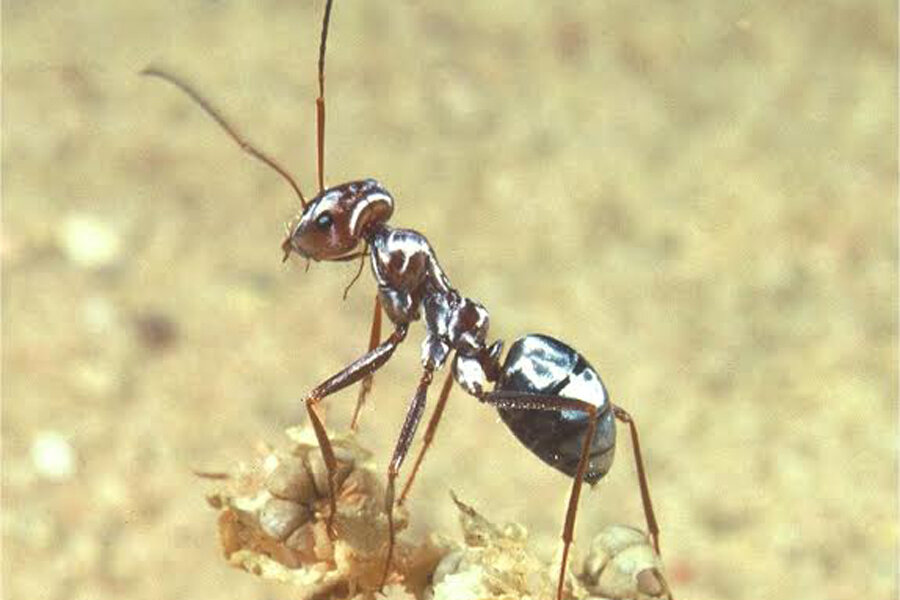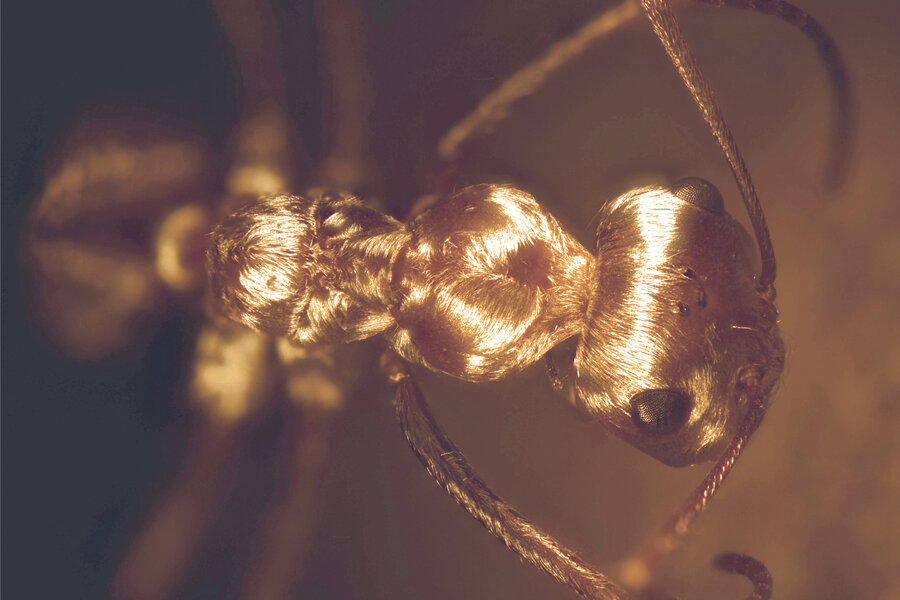How do half-inch ants survive the Sahara? Silver hairs, scientists say.
Loading...
For humans, silver hair can add a touch of sophistication. But for one species of desert ant, it means the difference between life and death.
In the oppressive heat of the Sahara, the silver ant needs all the help it can get to stay cool. Among other unique adaptations, this tenacious bug uses shimmering, silver hairs to lower its body temperature – a process described for the first time by Columbia University researchers in Thursday’s edition of Science Magazine.
The Saharan silver ant, or Cataglyphis bombycina, is a case study in extremes. Rather than face predators during cooler hours, silver ants only emerge from their dens at the hottest point in a Saharan day. Extra-long legs keep their bodies as far as possible from the hot sand, and special heat shock proteins allow them to withstand temperatures up to 128 degrees F. But these adaptations can only do so much – any more than 10 minutes in the sun means certain death for the silver ant, so they must hunt quickly, sprinting 70 times their body length every second.
But without one key feature, they might not survive the sweltering desert at all. Although these ants are known for their distinctive shiny coat, it was unclear before now whether the hairs played a role in temperature regulation. Using electron microscopy, Columbia physicist Nanfang Yu and colleagues were able to see the triangular structure of those hairs.
The results paint a stark picture of natural efficiency: By interacting with different types of electromagnetic radiation, silver hairs actually had a cooling effect on the ants.
“There are two effects – first in the shorter wavelengths of the solar radiation spectrum, secondly in the longer wavelength range of the thermal radiative spectrum,” Dr. Yu says. “In the solar spectrum, which is shorter wavelengths, the hairs scatter light very strongly. These hairs have triangular cross-sections with three flat facets, and those facets create an effect called total internal reflection, which helps increase the scattering efficiency for the solar light.”
In other words, the hairs aren’t just for style. Like many pale colors, the silver bounces sunlight off their surface, but the more interesting effect happens with thermal radiation. Because waves of thermal radiation are longer than the cross-sections of the hair, they are absorbed rather than reflected, and then they reflect around and around within the structure of the hair. And while absorption may sound counterproductive, it actually helps the ants cool down – as long as the sky is clear, as it often is in the Sahara.
“[The] sky has a very low radiative temperature,” Yu explains. “So there is a net radiative energy flow from the hot ant to the clear sky. The hairs are structured so this energy flow has the maximum rate. For example, when you get out of the bath in the morning, you feel cold. The reason you feel cold is partially that your body temperature in that moment is much higher than the surrounding environment. So there’s a net radiative energy transfer from your body to the surrounding environment.”
“If you combine these two effects, you have the best combination – it will block incoming sunlight and dissipate thermal energy when heated up,” Yu adds.
With an adaptive answer to almost every challenge hurled its way, the silver ant is incredibly well-suited to its harsh environment.
“This is very, very unique,” Yu says. “I’ve haven’t seen other examples [of animals] that are so close to perfect in every sense. It is highly reflective in the solar spectrum, so the energy intake is minimized, whereas it’s highly emissive in the thermal radiation spectrum, so the heat dissipation is maximized. This is the best thing you can do without electricity. You can only expect to see such extreme engineering in the biological world in such harsh environments.”
Last year, Stanford physicist and nanoscientist Shanhui Fan published a study on radiative cooling in the journal Nature. After meeting at a conference, Yu and Dr. Fan discussed their research and found some striking similarities. Namely, the working mechanism described in Fan’s paper was reflective under solar light and emissive under radiative wavelengths.
“We found that there was a very close correlation between the two studies,” Yu says. “It’s very interesting to see that the same mechanism [engineered] by humans is also used by animals to deal with harsh weather.”
Fan and his colleagues are already working to develop commercial applications for their technology, which is “fairly complex” in design, according to Yu.
But sometimes the simple efficiency of biological systems can give human tech a run for its money. Earlier this year, researchers speculated that the self-contained reaction chamber of the chemical-spraying bombardier beetle could inspire better combustion engines. Meanwhile, graduate student and co-author Norman Nan Shi is working on a cheap, simple, and flexible structure that mimics the microstructure of silver ant hair.
“If you had such a membrane or coating,” Yu says, “you could apply it to vehicles, or the roof of a building, or some hot machine that is exposed to solar radiation. It would also have to be exposed to clear skies, which is important. And if you can make a soft version of such a coating, you could even apply it to clothing so that you could enjoy cooler temperatures by a few degrees.”









